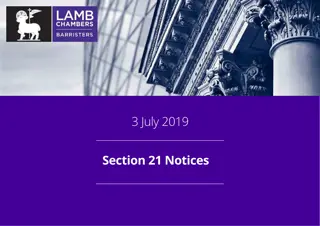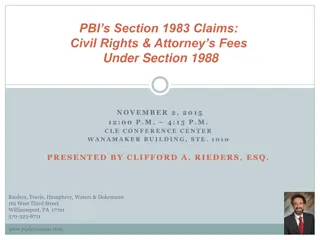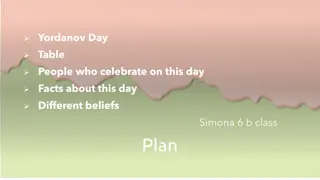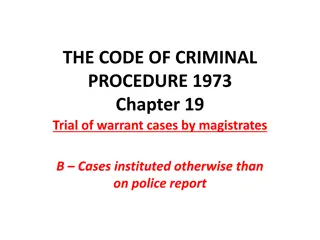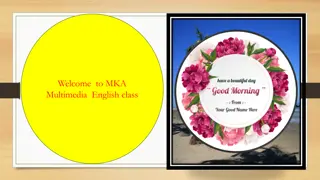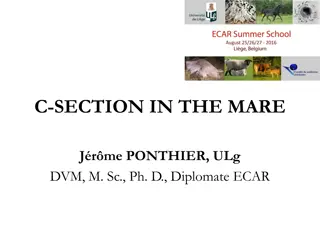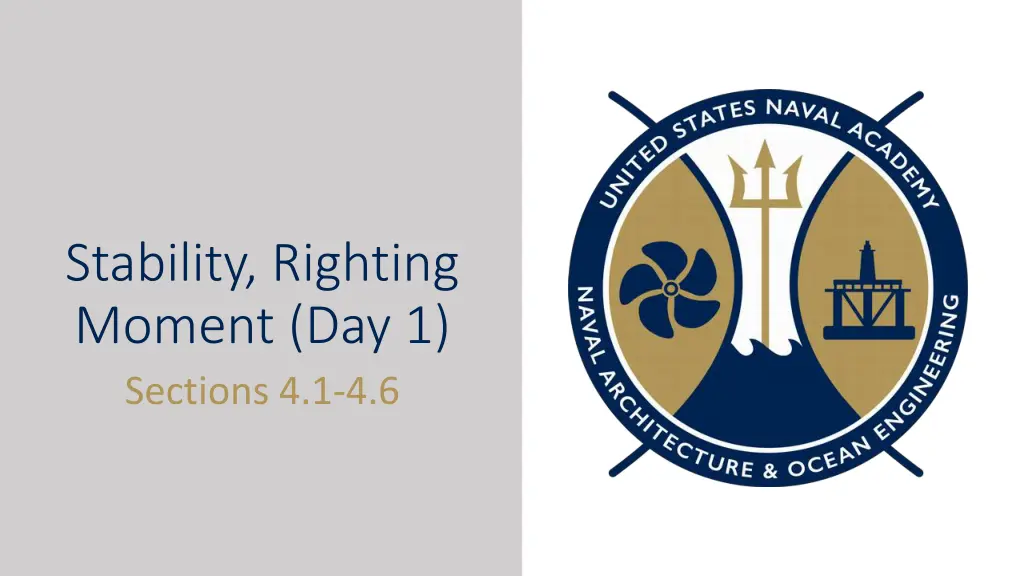
Understanding Ship Stability and Righting Moments
Explore the key concepts of stability and righting moments in naval architecture, focusing on external forces and moments impacting vessel equilibrium. Learn about the effects of wind, water resistance, and shifts in center of buoyancy on a ship's stability.
Download Presentation

Please find below an Image/Link to download the presentation.
The content on the website is provided AS IS for your information and personal use only. It may not be sold, licensed, or shared on other websites without obtaining consent from the author. If you encounter any issues during the download, it is possible that the publisher has removed the file from their server.
You are allowed to download the files provided on this website for personal or commercial use, subject to the condition that they are used lawfully. All files are the property of their respective owners.
The content on the website is provided AS IS for your information and personal use only. It may not be sold, licensed, or shared on other websites without obtaining consent from the author.
E N D
Presentation Transcript
Stability, Righting Moment (Day 1) Sections 4.1-4.6
Big Picture of EN400 Chapter 3 List and Trim angles created from weight shifts, no external forces FB perfectly aligned with displacement of ship No moments created Chapter 4 External forces to ship (wind) external moment created ship leans over (heel) Internal moment created to stop the leaning (Righting Moment)
External Forces Acting on a Vessel In Chapter 4 we will study five areas: 1. The concept of a ship s Righting Moment (RM), the chief measure of stability (today) 2. KG and TCG changes and their effects on RM 3. How Stability is effected by Damage to the Hull using the Added Weight method 4. Effects of a Free Surface 5. Effects of Negative GM on ship stability
External Moment Naval Architecture Website Demo https://ciechanow.ski/naval-architecture
Internal Righting Moment External Forces causes vessel to heel Reminder: Moment = Force x Distance External Moment can be caused by wind pushing on one side of the vessel and water resisting the motion on the other side Each distributed force can be resolved into a resultant force vector The wind acts above the waterline and the water resistance acts below the waterline
Forces Creating the External Moment MT Wind Water Resistance A ship in static equilibrium is affected by outside forces that will alter its state of equilibrium. The forces of wind- and the opposing force of the water below the waterline- will cause an external moment couple about the ship s center of flotation.
Shift in Center of Buoyancy MT Wind Water Resistance B The ship reacts to this external moment couple by pivoting about F, causing a shift in the center of buoyancy. The center of buoyancy will shift because the shape of the submerged volume will change. Note: there is no change in weight or it s distribution so there is NO change in the location of G!
Internal Moment Created MT s Wind Water Resistance B FB Because the location of B changes, the location of where the FB is applied also changes. Because G does not move, the location s is acting force does not change. The displacement force and the buoyant for are no longer aligned. The heeling over causes the creation of an internal moment couple.
Internal Righting Moment The two forces create a couple because they are equal in magnitude, opposite in direction, and not aligned The couple causes rotation or heeling The vessel will continue to rotate until it returns to Static Equilibrium (i.e. an Internal Moment is created which is equal in magnitude and opposite in direction). Giving M=0
External vs. Internal Moments MT s Wind Water Resistance B FB The external moment couple causes the creation of the internal moment couple to oppose it. As a result, the ship is now back into equilibrium, even as it heels over due to the wind force.
Righting Arm (GZ) MT Z B We are concerned with the created internal moment caused by the offsetting of the ship s weight and the buoyant force. The offset distance of the applied forces, GZ, is called the internal RIGHTING ARM. The length of this righting arm is a function of the heeling angle, .
Righting Arm (GZ) Naval Architecture Website Demo https://ciechanow.ski/naval-architecture
Righting Arm (GZ) Righting Moment (RM) MT s Z B FB Remember that a moment is created when a force acts at a distance from a given point. In the case of the created internal moment couple, we have the two force, s and FB, acting over the distance GZ. The created moment is called the internal righting moment On Equation Sheet (Ch. 4)
Internal Righting Moment Equation ?? = ?? = ?? ?? RM is the internal righting moment of the ship in ft-LT is displacement of the ship in LT FB is the magnitude of the resultant buoyant force in LT GZ is the righting arm in feet (distance from G to Z)
Intact Static Stability Curve MT s Z B FB This illustrates just one potential moment arm based upon one particular angle of . There are an infinite number of angles possible infinite number of moment arms that vary with the degree of heel, . If we can plot the heeling angle ( ) versus the created moment arm GZ, we can create the Intact Static Stability Curve.
Curve of Intact Statical Stability Curve of Intact Statical Stability Aka The Righting Arm Curve or GZ Curve Shows the Heeling Angle ( ) ( x-axis) versus the righting arm (GZ) (y-axis) Assumes the vessel is heeled over quasi-statically in calm water (i.e. external moments are applied in infinitely small steps)
Curve of Intact Statical Stability This is a typical curve. Notice that it plots the angle of heel on the x-axis and the righting arm on the y-axis. The curve is in both the 1st and 3rd quadrants (the 3rd shows a heel to port). Typically only the curve showing a heel to starboard is shown as it is symmetrical.
GZ Curve Naval Architecture Website Demo https://ciechanow.ski/naval-architecture/
Measure of Stability From the Curves of Intact Stability the following Measures of Overall Stability can be made: 1. Range of Stability 2. Maximum Righting Moment 3. Angle of Maximum Righting Moment 4. Dynamical Stability 5. Measure of Tenderness or Stiffness
Range of Stability (ROS) The range of angles for which there exists a positive righting moment. The greater the range of stability, the less likely the ship will capsize. If the ship is heeled to any angle in the range of stability, the ship will exhibit an internal righting moment that will right the ship if the external moment ceases. Range of Stability Righting Arm GZ (ft) Angles of Inclination: (Degrees)
Maximum Righting Moment The largest Static Moment the ship can produce. Calculated by multiplying the displacement of the vessel times the maximum Righting Arm. The larger the Maximum Righting Moment, the less likely the vessel is to capsize. Range of Stability Righting Arm GZ (ft) Maximum Righting Arm Angles of Inclination: (Degrees)
Angle of Maximum Righting Arm The angle of inclination where the maximum Righting Arm occurs. Beyond this angle, the Righting Arm decreases. It is desirable to have a larger maximum angle so that at large angles of heel in a rolling ship the righting moment will continue to increase. Range of Stability Righting Arm GZ (ft) Maximum Righting Arm Angle of Maximum Righting Arm Angles of Inclination: (Degrees)
Dynamical Stability The work done by quasi-statically rolling the ship through its range of stability to the capsizing angle. Area under the GZ Curve. (Qualitative, not quantitative) Does not account for the actual dynamics, because it neglects the impact of waves and momentum. Range of Stability Righting Arm GZ (ft) Dynamical Stability Maximum Righting Arm Angle of Maximum Righting Arm Angles of Inclination: (Degrees)
Measure of Tenderness or Stiffness The initial slope of the intact statical stability curve indicates the rate at which a righting arm is developed as the ship is heeled over. Range of Stability Slope is a measure of tenderness or stiffness. Righting Arm GZ (ft) Dynamical Stability Maximum Righting Arm Angle of Maximum Righting Arm Angles of Inclination: (Degrees)
Measure of Tenderness or Stiffness The initial slope of the intact statical stability curve indicates the rate at which a righting arm is developed as the ship is heeled over. A steep initial slope indicates the rapid development of a righting arm and the vessel is said to be stiff. Stiff vessels have short roll periods and react strongly to external heeling moments. (warship) A small initial slope indicates the slower development of a righting arm and the vessel is said to be tender. Tender vessel have longer roll periods and react sluggishly to external heeling moments. (cruise ship)
Measure of Stability GZ Curve Independent Analysis of 5 Properties to determine Stability of a Ship Range of Stability Slope is a measure of tenderness or stiffness. Righting Arm GZ (ft) Dynamical Stability Maximum Righting Arm Angle of Maximum Righting Arm Angles of Inclination: (Degrees)








